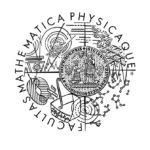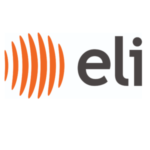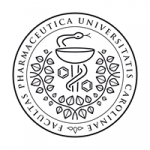Přehled
Faculty of mathematics and physics of the Charles university (Prague, Czechia) is accepting applications in PhD study programmes (to start studying in October 2024). Details on the requirements and the procedure can be found in the faculty admissions page [link] (deadline for applications is April 30). Practical info on living in Prague can be found [here].
The AMBER (CERN) experiment group at the faculty [our web] is offering a topic of the future PhD thesis and a supplementary scholarship to one applicant in the study programme of particle and nuclear physics. As explained in the faculty admission page, having an approved PhD topic helps in the entrance examination. The scholarship (in the form of a part-time job contract) would add to the default one given by the faculty to provide in total at least 30.000 CZK (about 1.200 EUR) per month and can be guaranteed for 2 years. The topic is described below.
Notes:
- The study may be conducted in cooperation with one of the AMBER collaboration institutions or with CERN.
- We also offer a PhD topic on COMPASS experiment [link].
- It may be possible (and preferable) to start the contract earlier (e.g. August), if the visa situation of the applicant allows.
Required qualificaton:
- Knowledge of particle (sub-nuclear) physics on Master degree level. Background in DAQ or front-end detector electronics would be appreciated.
- Experience with data analysis and computer programming, in the optimal case with ROOT (in C++ or Python) in particular.
- English for professional communication and scientific writing.
To apply for the thesis topic, please send your brief CV and motivation letter to Jan Matousek [email] and arrange for a letter of recommendation to be sent by a relevant referee as well.
Measurement of antiproton production and development of data acquisition and reconstruction tools at AMBER
The thesis topic consists of two parts. Depending on the qualification and interest of the student and needs of the collaboration, one or the other part may be given greater weight.
1. Measurement of the antiproton production cross section in proton-helium or proton-proton interactions
Measurements of the AMS spectrometer include the cosmic antiproton flux [AMS, Phys.Rep. 894, 2021]. They are expected to be produced dominantly in collisions of high energy proton cosmic rays with the interstellar medium, mostly hydrogen and helium, at rest. The AMBER collaboration [CERN-SPSC-2019-022] has collected data on 100-190 GeV protons scattering off a liquid helium target, an experiment with hydrogen target is being proposed as well [D. Giordano, PoS ICHEP2022 (2022) 1197]. Analysis of these data (together with complementary data from LHCb experiment in TeV domain) will significantly improve the knowledge of the cross section of this conventional antiproton production. That is necessary to assess if the measured flux leaves space for exotic antiproton sources such as dark matter annihilation [M. Korsmeier et al., FPhys.Rev.D97 (2018) 103019].
2. Development of trigger-less data acquisition and related tools
Other physics programme of the AMBER collaboration, measurements of the elastic mion-proton scattering and pion- and kaon-induced Drell-Yan process, requires to upgrade the detector readout. Instead of analogue triggering all the data will be acquired and their filtering will take place at higher (software) level, where the events can be partially reconstructed (high-level trigger) [M. Zemko et al., PoS ICHEP2022 (2022) 248]. The readout (front-end) electronics needs to be adapted to fit this system; new tools for event reconstruction and online monitoring of the data being collected need to be developed as well.




